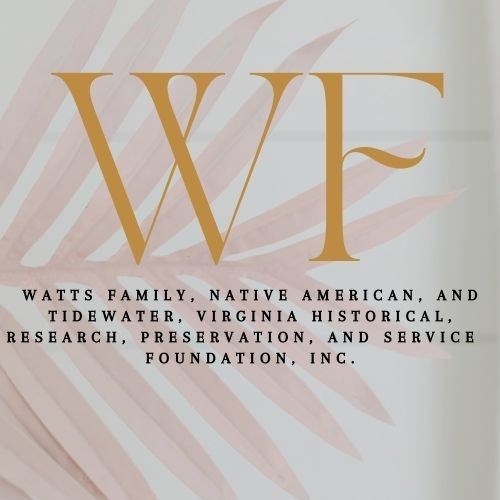Native American Roots
Genealogy and history of Native Americans of Granville County and Northeastern North Carolina
Search for:
The Nansemond Indian Bass Family of Granville
May 22, 2015UncategorizedAnderson, Bass, Bertie County, Chavis, Chesapeake, Chowan County, Cousins, Day, Evans, Gates County, Gibson, Goins, Haliwa-Saponi, Harris, Hawley, Horsepool Swamp, John Fulcher, Lumbee, Mayo, Meherrin, Mitchell, Nansemond, Nansemond County, Norfolk County, Northampton County, Nottoway, Occaneechi-Saponi, Perquimans County, Pettiford, Potecasi Creek, Powhatan, Robeson County, Skipper, Stewart, Suffolk, Taborn, Urahaw Swamp
The Bass family in Granville County is one of the larger, if not the largest Native American families in the county. It is a “core” lineage whose family members have intermarried with just about all other families of Native American descent in the community. The Basses have a well documented tribal origin with the Nansemond tribe who are indigenous to the Nansemond River area of lower tidewater Virginia. Today known as the Nansemond Indian Nation, the tribal nation received federal acknowledgement in 2018. Due to the rapid and increased colonization of the Nansemond homeland, many Basses settled in the “frontier” of North Carolina. The Bass family never lost knowledge of their Native American origins, and as a result, some of their descendants today can be found in a number of tribal communities such as: Haliwa-Saponi, Meherrin, Occaneechi-Saponi, and Lumbee. This blog post follows the migration of the Nansemond Bass family from Norfolk, Virginia to Granville County.
I continue to update and expand this blogpost with new research, so please check for updates. For quicker access, the blogpost is divided into the following sections:
- Nansemond Tribal Origin – Read about the earliest family records including the 1638 marriage record between John Bass(e) an English colonist and Elizabeth a Nansemond woman and other court records which shows the family’s continuous identity as Nansemond.
- Edward Bass (1672-1750) and John Bass (1673-1732) in Norfolk, Virginia – Direct ancestors resided in Norfolk before moving to North Carolin and left behind a paper trail.
- Edward Bass (1672-1750) and John Bass (1673-1732) Move to North Carolina – In 1720/1721 Edward Bass moved from Norfolk to Horsepool Swamp in what is today Gates Co on land adjoining his brother John Bass. From there, the brothers moved toghter to adjoining land on Urahaw Swamp in what is today Northampton Co
- Edward Bass/Bayes and Mary Tucker of the Chowanoke(?) – The family of Edward Bass, more commonly spelled Edward Bayes married an Indian woman named Mary Tucker and later lived in Deep Creek off of the Chowan River in what is today Hertford County, NC. Novice researchers sometimes mix up the records for these families so this section provides further analysis and clarification.
- A Closer Look at Urahaw Swamp and Neighboring Tribes – At Urahaw Swamp, Edward Bass and John Bass had some interesting neighbors that merit further scrutiny. Many of these neighbors joined the Basses when they moved next to Granville.
- The Nansemond Basses in Granville County – The Basses in Granville formed tight knit kinship circles and purchased large amounts of land that were kept in the family over generations by maintaining endogamous relationships.
- Nansemond Bass Genealogy in the Haliwa-Saponi Tribe – The Haliwa-Saponi Tribe identifies the Nansemond tribe as one of several ancestral tribes. This is documented in the genealogy of tribal ancestors Mary Bass, her first husband Elijah Bass (her second husband was Benjamin Richardson) and her brother Benjamin Bass Jr.
- Photos of Nansemond Basses from Granville County – Photos are a great way to humanize our ancestors. I am grateful to the many Bass relatives who have shared family photos.
Nansemond Tribal Origin
 Family Tree of the first generations of Bass family. John Bass(e), a colonist, married Elizabeth, daughter of the chief of the Nansemond tribe. This blog post focuses on their grandsons Edward Bass (1672-1750) and John Bass (1673-1732) who moved to North Carolina. Note: this tree only names the children of William Bass and Catherine Lanier who had known living offspring. William Bass and Catherine Lanier had a daughter named Keziah Bass who is documented in the Bass family papers as being born on 30 October 1675 and died as a spinster (archaic word for an unmarried woman) in 1704. According to her own Bass family, Keziah Bass never married and had no surviving children when she died in 1704. The exact words in the Bass family papers: “Keziah Bass, Junior, daughter of William Bass & Catherine Lanier, entered into eternal life in the year of our lord & savior 1704, at 28 years. A pious Christian spinster”. Any family trees that attach a husband named Edward Baldwin and children to Keziah Bass are not founded in any fact and are completely at odds with Nansemond tribal documents. © Kianga Lucas
Family Tree of the first generations of Bass family. John Bass(e), a colonist, married Elizabeth, daughter of the chief of the Nansemond tribe. This blog post focuses on their grandsons Edward Bass (1672-1750) and John Bass (1673-1732) who moved to North Carolina. Note: this tree only names the children of William Bass and Catherine Lanier who had known living offspring. William Bass and Catherine Lanier had a daughter named Keziah Bass who is documented in the Bass family papers as being born on 30 October 1675 and died as a spinster (archaic word for an unmarried woman) in 1704. According to her own Bass family, Keziah Bass never married and had no surviving children when she died in 1704. The exact words in the Bass family papers: “Keziah Bass, Junior, daughter of William Bass & Catherine Lanier, entered into eternal life in the year of our lord & savior 1704, at 28 years. A pious Christian spinster”. Any family trees that attach a husband named Edward Baldwin and children to Keziah Bass are not founded in any fact and are completely at odds with Nansemond tribal documents. © Kianga Lucas
Some of the source material for this blog entry comes from the research of Bass descendant and genealogist Lars Adams. Lars has invested a lot of time in correcting past research mistakes. His impressive article from 2012 titled “Why John Bass (died. 1732 in Bertie, Carolina) and his brother Edward were of Nansemond Descent”, is a helpful explanation of past Bass research errors and unequivocally documents how the Granville County branch of the Bass family is Nansemond. Nikki Bass is another Bass descendant and researcher who publishes her Bass related genealogy in a blog here. I also drew from Paul Heinegg’s research on the Bass family as well as from Albert Bell’s book, Bass Families of the South (1961). Both Heinegg and Bell have made some errors in their Bass genealogies, so throughout this blogpost you will see some corrections that I have made with my own research. And finally it is important to note that I author of this blog, Kianga Lucas, am a Nansemond Bass descendant which is how I first came to research the family and is why I am dedicated to preserving and sharing our family history. I believe it is imperative that we as Native peoples, lend voices to our own histories that have often been told by non-Natives.
Advertisements
REPORT THIS AD
The Nansemond branch of the English Bass family begins with the marriage in 1638 of John Bass(e) an English colonist to Elizabeth, baptized daughter of the chief of the Nansemond tribe. Their marriage was recorded in the Bass family sermon book that has survived to the present. Albert Bell’s book contained an incorrect transcription of this marriage record that falsely states Elizabeth’s name was “Keziah Elizabeth Tucker” and that her father was “Robin the elder”. However as you can read from a copy of the original marriage entry, her name is simply “Elizabeth” and her father’s name is not mentioned at all. “Keziah” is however a first name found frequently among descendants of the Nansemond Bass family, so it is possible that this mix-up comes from fractured memories of the family history. So if you are a Bass descendant or researcher, please check your family tree to make sure you have the correct information. Below is an image of the original marriage record in the Bass Family sermon book:
 Bass Family Sermon Book transcription:
Bass Family Sermon Book transcription:“John Basse married ye dafter of ye King of ye Nansemond Nation by name Elizabeth in Holy Baptizm and in Holy Matrimonie ye 14th day of August in ye yeare of Our Blessed Lord 1638 Dyed 1699 A.D.”
The Nansemond tribe is an Algonquian speaking tribe that at one point in history, was affiliated with the Powhatan Confederacy from the tidewater Virginia area that is today the modern city of Suffolk. As coastal people they were impacted very early on by European colonization. Below is a map of the locations of the sub-tribes of the Powhatan Confederacy:
 Map of the Powhatan Confederacy. The Nansemond Tribe is circled in red.
Map of the Powhatan Confederacy. The Nansemond Tribe is circled in red.Source: Helen Rountree
John Bass/e and Elizabeth the Nansemond had several children including a son named William Bass (1654-1741) who has well documented descendants. William Bass was married to a woman named Catherine Lanier and they made their home in what was then known as Lower Norfolk County, Virginia along the Western Branch of the Elizabeth River. William Bass Sr and Catherine Lanier had the following children:
- *Edward Bass b. 19 Oct 1672
- *John Bass b. 4 Dec 1673
- Keziah Bass b. 30 Oct 1675
- *William Bass b. 28 Oct 1676
- Joseph Bass b. 21 Dec 1678
- Mary Bass b. 15 Jun 1681
- *Thomas Bass b. 13 Nov 1687
Four sons: Edward, John, William, and Thomas are known to have had children and living descendants today. Sons William Bass Jr (1676 – 1761) and Thomas Bass (1687-?) and their descendants primarily remained in the Norfolk, VA area with Thomas Bass’ grandson William Bass (b. 1762) and his descendants moving across the state line into Camden County, NC and neighboring counties beginning in the late 1700s. These Basses commonly intermarried with other FPOC families such as: Hall, Perkins, Price, Archer, Newton, and Nickens.
Advertisements
REPORT THIS AD
On the other hand, sons Edward Bass (1672 – 1750) and John Bass (1673- 1732) relocated to North Carolina and their descendants I will document in the following sections. The descendants of both Edward Bass and John Bass are found in Granville.
William Bass Sr in 1726/1727 received a certificate from the Norfolk Co, VA court stating that:
An Inquest pertaining to possession and use of Cleared and Swamp lands in and adjoining ye Great Dismal by William Bass, Sr. and His kinsmen who claim Indian Privileges, Sheweth by the testimony of White Persons and sundry records of great age and known to be authentic, That said William Bass, Thomas Bass, and Joseph Bass and spinister daughter Mary Bass are persons of English and Nansemond Indian descent with no admixture of negro, Ethiopic, and that they and all others in kinship with them are freeborn subjects of his Majesty living in peace with his Majesty’s Government entitled to possess and bear arms as permitted by Treaties of Peace by and between Charles II of blessed memory and ye Indians of Virginia and the said William Bass, Sr. and als are in Rightful, and Lawful possession thereof and are not to be further Molested by any person or persons whatsoever under any pretended Authority under Penalties etc. etc., whilst ye said Bass and his kinsmen claim Indian privileges pursuant to the aforesaid Treaties of Peace.
17 day of March 1726/27
Solo. Wilson, Cl. Cur.
William Bass’ sons Edward Bass (1672-1750) and John Bass (1673-1732) are not included in this certificate because they had already relocated to North Carolina several years prior. However it is important to note that this certificate extended to all of William Bass’ kin who were not specifically named in the certificate. This is a compelling detail because it demonstrates that William Bass had the foresight to ensure all of his relations had these same treaty rights.
Advertisements
REPORT THIS AD
Later William Bass’ son William Bass Jr (1676-1761) received a similar certificate in 1742 that read:
William Bass, the Bearer, tall, swarthy, dark eyes, weight abt. 13 stone, scar on back of left hand, is of English & Indian descent with no admixture of negro blood, numbered as a Nansemun by his own Choosing. The sd. Bass dwells in this County and hath a good name for his industry and honesty.
Clearly the Bass family early on was attempting to document and secure their Nansemond Indian identity and treaty rights and in order to do this, it required them to distance themselves from any “negro admixture”. This theme of distancing and denying African admixture, in order to substantiate Indian identity is a common theme throughout Native American communities in the Southeast. And it has unfortunately had devastating effects that fractured families who had relatives deemed “too African” in phenotypical appearance. It has also impacted the political recognition of tribal communities. Even the Native Americans of Granville County adamantly denied African admixture as can be seen in the writings of local historian Oscar Blacknall that you can read more about here. Elder cousins have shared anecdotal stories with me on the topic of race/racial appearance, that are consistent with Blacknall’s observations about our community.
 Augustus Bass sitting on the far left with other members of his family in Norfolk County, VA.
Augustus Bass sitting on the far left with other members of his family in Norfolk County, VA.Augustus Bass is a descendant of William Bass Jr (1676-1761), whose family remained in Norfolk, Virginia.
William Bass Sr, wrote a will on 1 Oct 1740 which was proved on 17 Sep 1742 in Norfolk County. In the will, William gives his sons William, Edward and Thomas only one shilling each. He gave to his son Joseph Bass, his “waring cloaths” and left his land and anything else to his daughter Mary in the hopes that she salvage what is left. Clearly, William Bass was not in good financial standing at the time of his death. Son John Bass (1673-1732) is not named in the will because he predeceased his father. This is also true for William’s daughter Keziah Bass who died in 1704. It is important to point out that by 1740, son Edward Bass (1672-1750) had lived in North Carolina for twenty years, yet his father William Bass still made sure to include him in his will. This shows that Edward Bass was still in touch with his family and community back in Norfolk, VA.
 This is the original handwritten will of William Bass (1654-1741). Source: Virginia, Wills and Probate Records, 1652-1983; Norfolk; Original Wills, 1693; page 427.
This is the original handwritten will of William Bass (1654-1741). Source: Virginia, Wills and Probate Records, 1652-1983; Norfolk; Original Wills, 1693; page 427.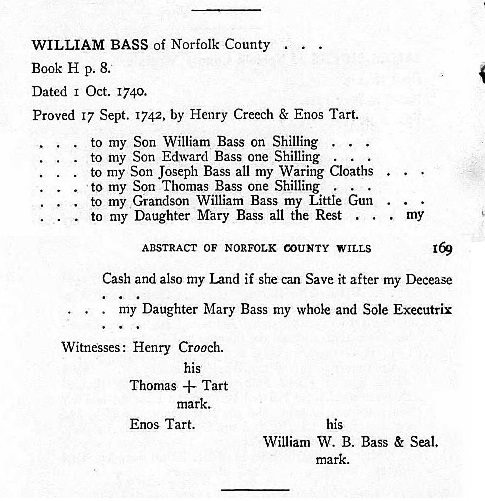 Transcription of the will of William Bass dated 1 Oct 1740 and proved on 17 Sep 1742 in Norfolk Co, VA
Transcription of the will of William Bass dated 1 Oct 1740 and proved on 17 Sep 1742 in Norfolk Co, VA
Edward Bass (1672-1750) and John Bass (1673-1732) in Norfolk, Virginia
Before moving to North Carolina, brothers Edward Bass and John Bass spent the early part of their adulthood in Norfolk. What follows is a discussion of the located records for both brothers in Norfolk. These early records help to establish their presence among their fellow Nansemond kinsmen. On 17 Nov 1698, Edward Bass appeared in Norfolk court to admit that he owed 500 lbs of tobacco to Hugh Campbell. Hugh Campbell was a Scottish born merchant who was licensed to operate in the West Indies and who later settled in Norfolk. Campbell was also a merchant of human chattel when it was recorded on 8 Jun 1680 that he was paid for transporting an enslaved Indian woman of Bermuda into the Virginia colony.
Advertisements
REPORT THIS AD
The following year on 16 Nov 1699, Edward Bass purchased 15 acres of land on the Western Branch of the Elizabeth River, from John Fulcher. This is the same John Fulcher whose 1712 will freed the Anderson slaves. Over the next several generations, the offspring of these freed slaves repeatedly intermarried with Edward Bass’ offspring. The Andersons moved with the Basses out of Norfolk and into Granville and became one of the core families of the community. My blog post on the Andersons can be found here. Thus, it appears there is a yet unknown direct relationship between Edward Bass and John Fulcher (perhaps Edward Bass’ wife was a relative of John Fulcher?).
In June 1702, Edward Bass was back in Norfolk court to confess to owing 70 lbs of tobacco to the estate of William Whitakers. Edward Bass and Thomas Whitfield (another person who was also in debt to the estate) signed their names to the document. This is a truly remarkable record because Edward Bass signed his name to the document with the initial “B’ faced down. Not only does it show that Edward Bass was at minimal partially literate, but just like in the modern era, his signature helps to confirm his identity. When Edward Bass later relocated to Urahaw Swamp in Northampton Co, NC, he signed his 1748 will (proved in 1750) with the exact same signature. This is undeniable proof that the Edward Bass of Urahaw Swamp was the same Edward Bass of Norfolk.
 The Norfolk County deed book shows that in 1702, Edward Bass (1672-1750) acknowledged he owed a debt to the estate of William Whitakers, by signing his name with the letter “B” faced down.
The Norfolk County deed book shows that in 1702, Edward Bass (1672-1750) acknowledged he owed a debt to the estate of William Whitakers, by signing his name with the letter “B” faced down.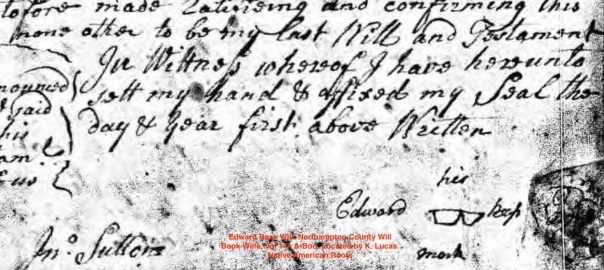 The will of Edward Bass (1672-1750) in Northampton County, NC shows his signature as a the letter “B’ faced down. This is the same way he signed a document in Norfolk, VA in 1702.
The will of Edward Bass (1672-1750) in Northampton County, NC shows his signature as a the letter “B’ faced down. This is the same way he signed a document in Norfolk, VA in 1702.
On 15 Nov 1709, Edward Bass sued Henry Lawley for a 3 lb debt. Edward Bass was brought to the Norfolk court again on 20 July 1711 for retailing liquor without a license. The charges were subsequently dropped. On 16 Dec 1715, Edward Bass sued John Muns Jr for 20 lbs for unlawfully riding his mare. There are additional Norfolk records which show a pattern of Edward Bass being harassed by his Anglo neighbors through a series of lawsuits that were dismissed by the courts. Ultimately what we can learn from these records is that Edward Bass was a land owner on the Western Branch of the Elizabeth River, likely had a farm, and earned enough money to make large purchases. The records also demonstrate his knowledge of the laws and court system, as he was a plaintiff in a few of the cases. This pattern of harassment by his Anglo neighbors may have played a large part in Edward Bass’ leaving the area and moving to the North Carolina frontier.
Advertisements
REPORT THIS AD
To date, located records for his brother John Bass in Norfolk are not nearly as numerous. On 15 October 1701 in Norfolk court, John Bass paid the costs for a suit brought against him by Thomas Hodges. This is the only record I know of for John Bass in Norfolk. Hopefully more records are uncovered for him, to better understand his life and his relationships in Norfolk before he settled in North Carolina.
Edward Bass (1672-1750) and John Bass (1673-1732) Move to North Carolina
 This map shows the movement of brothers Edward Bass (1672-1750) and John Bass (1673-1732) from their Nansemond homeland in Virginia to North Carolina and that they moved together from Norfolk, to Horsepool Swamp, and then to Urahaw Swamp. All of Edward Bass’ children and four of John Bass’ children moved and settled in Granville County by the 1750s. © Kianga Lucas
This map shows the movement of brothers Edward Bass (1672-1750) and John Bass (1673-1732) from their Nansemond homeland in Virginia to North Carolina and that they moved together from Norfolk, to Horsepool Swamp, and then to Urahaw Swamp. All of Edward Bass’ children and four of John Bass’ children moved and settled in Granville County by the 1750s. © Kianga Lucas
Edward Bass (1672-1750)
From here our discussion shifts to documenting Edward Bass’ (1672-1750) and John Bass’ (1673-1732) movement into North Carolina. Let’s first start with Edward Bass. The last known record of him in Norfolk was recorded in 1715. By 1720/1721, Edward Bass owned land in Horsepool Swamp in Chowan County (modern Gates County), North Carolina. In that land deed dated 30 January 1720/21, he is called “Edward Bass of Norfolk County, Virginia, Parish of Elizabeth”, so we know he is the same Edward Bass from Norfolk. Edward Bass’ brother John Bass purchased adjoining land on Horsepool Swamp on the exact same day.
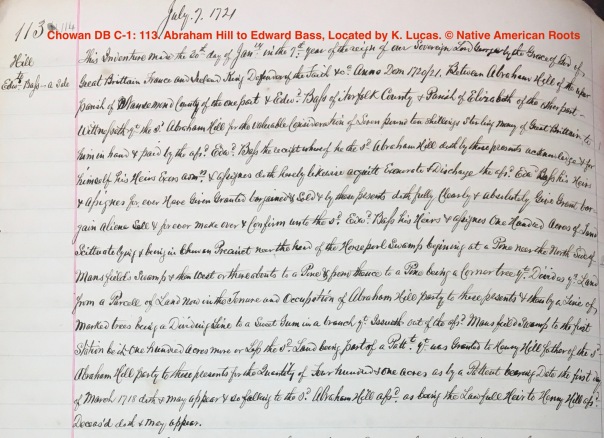 This document records when Edward Bass (1672-1750) first became a resident of Chowan County (now Gates County), North Carolina in 1720/1721. Abraham Hill of Nansemond County, VA sold to Edward Bass of the Parish of Elizabeth, Norfolk County, VA, land at Horsepool Swamp. On this same day, Abraham Hill sold adjacent land to Edward Bass’ brother John Bass (1673-1732).
This document records when Edward Bass (1672-1750) first became a resident of Chowan County (now Gates County), North Carolina in 1720/1721. Abraham Hill of Nansemond County, VA sold to Edward Bass of the Parish of Elizabeth, Norfolk County, VA, land at Horsepool Swamp. On this same day, Abraham Hill sold adjacent land to Edward Bass’ brother John Bass (1673-1732).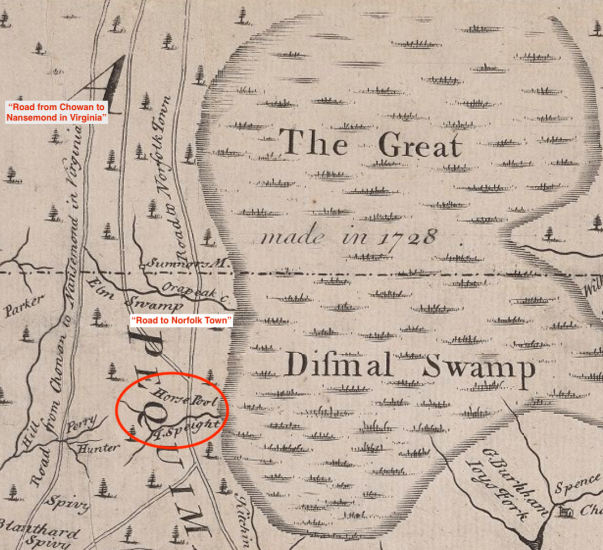 This detail from the 1733 Moseley map shows how close Horsepool Swamp is to the Virginia/North Carolina border. Two nearby roads would have provided Edward Bass direct access from his old home in Norfolk to his new home in Horsepool Swamp.
This detail from the 1733 Moseley map shows how close Horsepool Swamp is to the Virginia/North Carolina border. Two nearby roads would have provided Edward Bass direct access from his old home in Norfolk to his new home in Horsepool Swamp.
Edward Bass did not remain on the Horsepool Swamp land for long, because on 26 March 1723 he purchased 200 acres of land along Urahaw Swamp in what was then Bertie County and what is today Northampton County, NC. On 28 March 1726, while a resident of Bertie County, Edward Bass sold his Chowan County Horsepool Swamp land.
 On 28 March 1726 while a resident of Bertie County, Edward Bass (1672-1750) sold the Horsepool Swamp land in Chowan County that he had previously purchased in 1720/1721. This document shows that the Edward Bass who bought the Horsepool Swamp land in Chowan County (where he was called a resident of Norfolk County, VA) was by 1726 a resident of Bertie County. Tracking people through land deeds is great way to trace people over time because the land descriptions are specific and give the current residences of the grantor and grantee.
On 28 March 1726 while a resident of Bertie County, Edward Bass (1672-1750) sold the Horsepool Swamp land in Chowan County that he had previously purchased in 1720/1721. This document shows that the Edward Bass who bought the Horsepool Swamp land in Chowan County (where he was called a resident of Norfolk County, VA) was by 1726 a resident of Bertie County. Tracking people through land deeds is great way to trace people over time because the land descriptions are specific and give the current residences of the grantor and grantee.
Over the next couple of decades, Edward Bass purchased an additional 615 acres of land adjoining his Urahaw Swamp land in Northampton County, bringing his total land ownership to 815 acres (Bertie DB C: 135, Northampton DB 1: 40, 89, 129). On 25 July 1748, Edward Bass wrote his will which was proved in August 1750. The will named Edward Bass’ children who all inherited shares of their father’s land, thus making it possible to trace out his descendants. Edward Bass’ oldest living son Benjamin Bass (1722-1800) was named executor of the estate. We know this is the correct will for Edward Bass (1672-1750) because the will makes very specific and detailed descriptions of his Urahaw Swamp land that he divided among his offspring. The will also named Edward Bass’ widow as Lovewell. She was called “Love”, when she and husband Edward Bass sold their Horsepool Swamp land in 1726. There is no surviving marriage record for the couple, so Lovewell’s maiden name and origin is unknown. Edward Bass likely married her when he still resided in Norfolk, so she is perhaps from one of the families who were neighbors to the Basses and perhaps she was Nansemond.
 Page 1 of the will of Edward Bass (1672-1750). Source: https://digital.ncdcr.gov/digital/collection/p16062coll41/id/412
Page 1 of the will of Edward Bass (1672-1750). Source: https://digital.ncdcr.gov/digital/collection/p16062coll41/id/412 Page 2 of the will of Edward Bass (1673-1750). Source: https://digital.ncdcr.gov/digital/collection/p16062coll41/id/412
Page 2 of the will of Edward Bass (1673-1750). Source: https://digital.ncdcr.gov/digital/collection/p16062coll41/id/412
All of Edward Bass’ children moved from Northampton to Granville County beginning in the 1750’s. Soon after settling in Granville, they sold their shares of the Urahaw Swamp land in Northampton that they inherited from their father. The Anderson family who was freed in 1712 in Norfolk, made the move with the Basses to Northampton County and then to Granville County where the families continued to frequently intermarry. You can read more about the Andersons and their roots in Norfolk here. When Edward Bass’ children arrived in Granville with the Anderson family, they became neighbors and intermarried with the already established and land owning Chavis, Harris, Pettiford, Hawley, Goins, Evans, and Mitchell families.
 The family tree of Edward Bass (1672-1750) who was the grandson of John Bass/e and Elizabeth the Nansemond. His Northampton County will named all of his living children who each inherited a share of his land. All of Edward Bass’ children moved to Granville County and continued to intermarry with Native American/FPOC. It is interesting that Dinah Bass’ husband was named John Pone. “Pone” is a Virginia Algonquian word for unleavened cornbread and thus infers that John Pone, like his wife Dinah Bass, was of a Virginia Algonquian speaking background. © Kianga Lucas
The family tree of Edward Bass (1672-1750) who was the grandson of John Bass/e and Elizabeth the Nansemond. His Northampton County will named all of his living children who each inherited a share of his land. All of Edward Bass’ children moved to Granville County and continued to intermarry with Native American/FPOC. It is interesting that Dinah Bass’ husband was named John Pone. “Pone” is a Virginia Algonquian word for unleavened cornbread and thus infers that John Pone, like his wife Dinah Bass, was of a Virginia Algonquian speaking background. © Kianga Lucas
John Bass (1673-1732)
The offspring of Edward Bass’ brother John Bass (1673-1732) are also found in the Granville community, but they are not as numerous as Edward’s offspring. John Bass was first married to Love Harris. A record of their 1696 marriage in Perquimans Co, NC still exists:
 John Bass and Love Harris marriage recorded in Perquimans County, NC.
John Bass and Love Harris marriage recorded in Perquimans County, NC.“John BAS and Love HARRIS was Married ye 8th day of Janewary 1696 both of Nanse Mum County and Nanse Mum Parresh by Mager Samuel SWANN Esqr.”
As researcher Lars Adams pointed out in his article, despite John Bass and Love Harris both being residents of Nansemond County, VA (formerly Upper Norfolk County) they married in Perquimans County, North Carolina. John Bass who was Indian and Love Harris who was probably white were a couple during a time period where Virginia passed strict laws forbidding interracial marriages. So they may have married in North Carolina where the laws against interracial marriages were not as strictly enforced.
Advertisements
REPORT THIS AD
As discussed in the previous section there is one located record for John Bass (1673-1732) in Norfolk from 1701. He next appears on a land deed in 1719. On 14 July 1719 in Perquimans County, NC, Thomas Speight sold John Bass 300 acres.
 This Perquimans Co land deed from 1719 is the first time John Bass (1673-1732) is documented as a land owner in North Carolina.
This Perquimans Co land deed from 1719 is the first time John Bass (1673-1732) is documented as a land owner in North Carolina. The 1719 Perquimans land deed continues. Though no description of the bounded land is provided, it is documented in previous land deeds that Thomas Speight lived on Horsepool Swamp.
The 1719 Perquimans land deed continues. Though no description of the bounded land is provided, it is documented in previous land deeds that Thomas Speight lived on Horsepool Swamp.
The land deed does not provide the residence of either man, nor a description of the bounded land. However, further research into Thomas Speight (1670-1737) shows that he was a resident of Perquimans County who lived on Horsepool Swamp. He was the grandson of a man named Francis Speight who emigrated from England to Jamestown in 1635. By 1654, Francis Speight moved further south into Nansemond County (right on the Virginia – North Carolina border) where his grandson Thomas Speight (1670-1737) was born and raised before coming across the border to Perquimans County. The excellent genealogy blog, Sally’s Place, which documents the colonial history of the Chowan-Roanoke areas, has a detailed discussion about Thomas Speight found here. We can also see from the 1733 Moseley Map that land owner Thomas Speight is identified as living in Horsepool Swamp. There may be a yet discovered earlier link between the Speight and Bass families, given that the Speights lived in Nansemond territory and later sold land to a Nansemond man.
 This is a detail from the 1733 Moseley map showing Thomas Speight – “T. Speight” as a land owner on Horsepool Swamp which is also identified on the map. Horsepool Swamp is immediately adjacent to the Great Dismal Swamp. This is where John Bass (1673-1732) moved to in 1719 as documented in the land deed.
This is a detail from the 1733 Moseley map showing Thomas Speight – “T. Speight” as a land owner on Horsepool Swamp which is also identified on the map. Horsepool Swamp is immediately adjacent to the Great Dismal Swamp. This is where John Bass (1673-1732) moved to in 1719 as documented in the land deed.
The following year on 30 January 1720/1721, John Bass made another purchase of land on Horsepool Swamp for 200 acres in Chowan County (now Gates Co), NC on the exact same day as his brother Edward Bass purchased an adjoining lot from the same grantor – Abraham Hill. This shows a concerted effort by the brothers to remain quite close as a family unit in North Carolina.
 On 30 January 1720/1721, John Bass (1673-1732) purchased 200 acres from Abraham Hill on the exact same day that his brother Edward Bass (1672-1750) purchased an adjoining 200 acres also from Abraham Hill. In this land deed John Bass is called a resident of Chowan County because he had moved to the area a year earlier. This is unlike his brother Edward Bass who is called a resident of Norfolk in his Horsepool Swamp land deed because he had not moved yet.
On 30 January 1720/1721, John Bass (1673-1732) purchased 200 acres from Abraham Hill on the exact same day that his brother Edward Bass (1672-1750) purchased an adjoining 200 acres also from Abraham Hill. In this land deed John Bass is called a resident of Chowan County because he had moved to the area a year earlier. This is unlike his brother Edward Bass who is called a resident of Norfolk in his Horsepool Swamp land deed because he had not moved yet.
And just like his brother Edward Bass, John Bass then moved to Urahaw Swamp in 1722 in what was then Bertie County (now Northampton County). Numerous land deeds (Bertie DB A: 105, 129; Bertie DB C: 126, 135) where he accumulated a total of 1,060 acres of land that adjoined his brother Edward Bass (1672-1750). John Bass died young in 1732. Fortunately he left a Bertie County will which divided his Urahaw Swamp land among his children and named his oldest son John Bass Jr (born 1700) as the executor of the estate. As a result, John Bass’ (1673-1732) children and their descendants are well documented in the will and subsequent land deeds dealing with the division and sale of their inherited land. John Bass (1673-1732) also died several years before the area he was living in became Northampton County in 1741.
 John Bass (1673-1732) left a 1732 Bertie Co will that was also proved in the same year. We know this is the correct will attributed to John Bass (1673-1732) because he describes in detail his Urahaw Swamp land to be divided among his offspring.
John Bass (1673-1732) left a 1732 Bertie Co will that was also proved in the same year. We know this is the correct will attributed to John Bass (1673-1732) because he describes in detail his Urahaw Swamp land to be divided among his offspring. John Bass’ (1673-1732) Bertie Co will continues. At the top of this page John Bass wills his son Moses Bass land adjoining his brother Edward Bass. He directly calls Edward his brother so there can be no doubt that the John Bass and Edward Bass who lived on adjoining land in Urahaw Swamp in the early 1700s, are brothers by their very own words.
John Bass’ (1673-1732) Bertie Co will continues. At the top of this page John Bass wills his son Moses Bass land adjoining his brother Edward Bass. He directly calls Edward his brother so there can be no doubt that the John Bass and Edward Bass who lived on adjoining land in Urahaw Swamp in the early 1700s, are brothers by their very own words.
It should be noted that John Bass’ will makes mention of his widow Mary, and in it, John leaves his plantation to her as gift for “bringing up my small children”. Since we have an earlier marriage record for John Bass to Love Harris, this would mean that Love died sometime earlier, and John Bass remarried Mary. The will seems to indicate that Mary helped raise the children that John Bass had with his previous wife.
 Family tree of John Bass (1673-1732) that shows his children and their spouses/partners if documented. Four of is his children: Sarah Bass, William, Bass, Lovey Bass, and Mary Bass moved from Urahaw Swamp to Granville County. © Kianga Lucas, Native American Roots
Family tree of John Bass (1673-1732) that shows his children and their spouses/partners if documented. Four of is his children: Sarah Bass, William, Bass, Lovey Bass, and Mary Bass moved from Urahaw Swamp to Granville County. © Kianga Lucas, Native American Roots
Some of John Bass’ children remained in Northampton County and neighboring/nearby counties including Bertie, Edgecombe, Nash and Halifax. These offspring typically intermarried with wealthy, slave owning, planter families, and were often documented as “white”, Subsequent generations moved to the deep South to expand their plantation economies. Other children moved to other parts of the state. For example, John Bass’ grandson Frederick Bass (b. 1750) moved to Anson Co and some of his descendants can be found among the Lumbee Tribe in Robeson Co.
Advertisements
REPORT THIS AD
Four (4) of John Bass’ children did join Edward Bass’ children in their relocation to Granville Co. They were Sarah Bass b. 1704, William Bass b. 1712, Lovey Bass b. 1720 and Mary Bass b. 1722. Sarah Bass b. 1704 was the wife of Lewis Anderson (1713-1785), of the freed Anderson family of Norfolk Co, so that explains why she moved to Granville. Lovey Bass b. 1712 was not married but had a partner with whom she had children with named George Anderson (1696-1771) who was also of the Anderson family. She also had at least one child with Bartlet Tyler (b. 1742) from the FPOC Tyler family of Native American origins, that often intermarried with and were neighbors to the Basses in Granville over subsequent generations. The wife of William Bass b. 1712 is unknown but I wonder if she was also an Anderson. Mary Bass b. 1722 married her first cousin Benjamin Bass (1722-1800) who was the son of Edward Bass (1672-1750). On 26 July 1784, Mary Bass (while married to Benjamin Bass) sold the 100 acres of land along the Urahaw Swamp that she inherited from her father John Bass in 1732. Just like Edward Bass’ children, John Bass’ children who moved to Granville married into and became a part of the Native American community.
Edward Bass/Bayes and Mary Tucker of the Chowanoke(?)
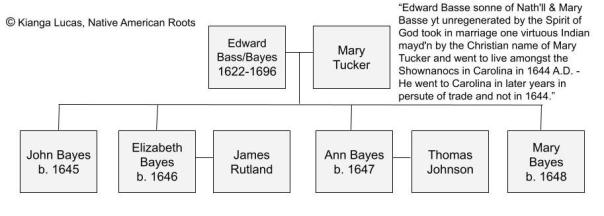 Family Tree of Edward Bass/Bayes, of the Bass Family sermon book. Birth dates of his children are approximations based upon the fact that Edward Bass/Bayes married Mary Tucker in 1644.
Family Tree of Edward Bass/Bayes, of the Bass Family sermon book. Birth dates of his children are approximations based upon the fact that Edward Bass/Bayes married Mary Tucker in 1644.
The Bass family sermon book shows that John Bass(e) (1616-1699) had a brother named Edward Bass who was born in 1622. The exact entry reads as follows:
Edward Basse ye sonne of Nathaniell Basse and Mary his wife was borned ye 8th day of Maye in ye yeare of God 1622.
It is also learned in the Bass sermon book that Edward Bass married an Indian woman named Mary Tucker and that they later went to live among the Chowanoke. This entry has been mis-transcribed and misinterpreted over the years, so please be sure to read the exact transcription:
 Original entry from the Bass family sermon book which recounts how Edward Bass (born 1622) married Mary Tucker and later lived among the Chowanoke “Showanocs”.
Original entry from the Bass family sermon book which recounts how Edward Bass (born 1622) married Mary Tucker and later lived among the Chowanoke “Showanocs”.
Edward Basse sonne of Nath’ll & Mary Basse yt unregenerated by the Spirit of God took in marriage one virtuous Indian mayd’n by the Christian name of Mary Tucker and went to live amongst the Shownanocs in Carolina in 1644 A.D. – He went to Carolina in later years in persute of trade and not in 1644
There are no other entries for Edward Bass found in the sermon book, so we are left to make sense of this odd entry. We learn that Edward Bass married a Christian Indian woman given the name Mary Tucker but her tribe is not directly identified. This is different from the John Bass(e) and Elizabeth marriage entry which makes it clear that Elizabeth was the daughter of a “king” of the Nansemond. It could be assumed that Mary Tucker was Chowanoke but it seems odd that the entry doesn’t directly call her Chowanoke. It could also be assumed that Mary Tucker was Nansemond given that the Bass family lived next to the Nansemond tribe in Norfolk and that Edward Bass(e)’s brother John Bass(e) married a Nansemond woman. The other odd part about the marrige entry is the timing of when Edward Bass went to live in North Carolina among the Chowanoke. The entry initially claims Edward Bass moved in 1644 when the wedding took place. But the entry then corrects itself and says he went to North Carolina in later years to pursue trade. Therefore an exact date of when he moved to North Carolina is not given but we can safely deduce that at some point in his life, after he married, Edward Bass went to North Carolina.
Advertisements
REPORT THIS AD
A will was recorded in Chowan County, NC in 1696 for an Edward Bayes and the information in the will seems to match what is known about Edward Bass (b. 1622). Most researchers attribute this 1696 will of Edward Bayes to Edward Bass (born 1622) of the Bass sermon book and I agree though I always look for additional confirming information. To avoid confusion, I will consistently use the surname “Bayes” to described Edward Bayes and his descendants whose surname is always shown in primary source records as “Bayes” or “Bays” An exact transcription of the Edward Bayes will reads as follows:
In the nanme of God Amen the 8th Day of August Anno /Dom 1696E Edward Bayes of Albemarle in the precinct of Chowan being sick of body but of sound & perfect memory thanks be to Almighty God for it and ______to mind the uncertainty (?) of theis Transitory life & I doe make ordain & Declaire this to be my last Will & Testament & noe other revoking __And for___being _____and ____for my ____ ____ ___ And for Settling my Temporal _____and Suit goods as it hath pleased God he b_____upon and above my Desires I doe Order good and dispose of the Same in manner & forme followeth I make my Loving Wife Mary Bayes my Whole and Sole Executrix of this my Will Item I give to my Son John Bayes One yearling heffer to be delivered unto him within a Month after my Decease wth all her female increase Item I give unto my Three Daughters Three yearling Heifers to be Delivered to them Sometime wthin Three years after my Decease wth all their femal increase the first year and to my Daughter Eliz Bayes The second year and to my Daugther Mary Bayes the third year one to my Daughter Ann Bayes. Item I give to my loveing Wife Mary Bayes my plantation dureing her natural life and after her Decease to Desend to my Son John Bayes the remaining part of my whole estate I give to my loveing Wife Mary Bayes and for the ____ of this being my last Will & Testament I have hereunto sett my hand & seal the Day & year above written.
Source: Edward Bass I (Bayes), Will, August 8, 1696, Chowan County Court, Proved October 8, 1696, Secretary of State Records, State Archives of North Carolina, SS 839-SS 861, MARS ID 12.96.2.50
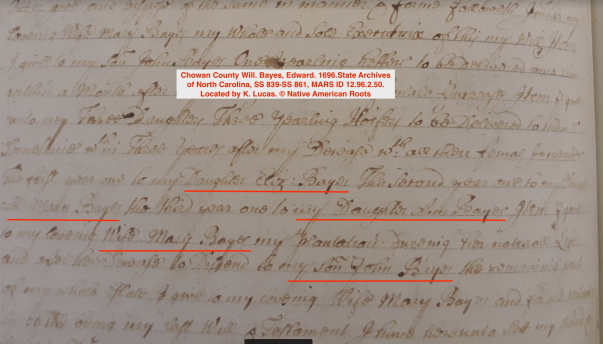 This is a section of Edward Bayes’ 1696 will recorded in the Chowan County will book. It is a very faded and hard to read copy, so I have underlined the portions where Edward Bayes identified his wife Mary, and children John, Eliza, Mary, and Ann.
This is a section of Edward Bayes’ 1696 will recorded in the Chowan County will book. It is a very faded and hard to read copy, so I have underlined the portions where Edward Bayes identified his wife Mary, and children John, Eliza, Mary, and Ann.
From the 1696 will we learn that Edward Bayes left a surviving spouse named Mary, one son named John and three daughters named Eliza, Mary, and Ann. We also learn that he was a land owner because he left his plantation to his wife Mary who would then pass it on to their son John upon her death. In 1696, Chowan County (“Precinct”) covered a vast amount of unbounded land that stretched along both side of the Chowan River. Where exactly in the vast territory called Chowan did Edward Bayes live?
 In 1700, just a couple of years after Edward Bayes made his 1696 will, Chowan County represented a vast territory.
In 1700, just a couple of years after Edward Bayes made his 1696 will, Chowan County represented a vast territory.
Subsequent records located for the offspring of Edward Bayes, show that he resided off of Deep Creek in what is now the town of Winton in Hertford County, NC. By the early 1700s, there were several other places called Deep Creek within the Chowan Precinct – these include Deep Creeks in what is today Gates, Northampton, and Bertie Counties (this one was also called Indian Creek). However none of these other Deep Creeks are the Deep Creek where Edward Bayes resided. One of my favorite genealogy blogs – “Andersons of Colonial N. Carolina” which does an excellent job of documenting colonial history of Virginia and the Carolinas, created a helpful map of the land owners along Deep Creek in the early 1700s. John Bayes (“John Bays”) and his son in law James Rutland are documented on the map in the top left:
 John Bayes (“Bays”) and his son in law James Rutland are documented living on Deep Creek in what is today the town of Winton in Hertford County, NC. Source: https://andersonnc.com/2016/08/19/john-browne-property-and-the-wayward-granddaughter/
John Bayes (“Bays”) and his son in law James Rutland are documented living on Deep Creek in what is today the town of Winton in Hertford County, NC. Source: https://andersonnc.com/2016/08/19/john-browne-property-and-the-wayward-granddaughter/
Deep Creek is a tributary of the Chowan River – a major trading route. That there were numerous trading families, including the Bayes, set up at Deep Creek should come as no surprise. This is consistent with the Bass sermon book which indicated that Edward Bass moved to North Carolina to pursue trading. The 1733 Moseley Map shows that the Chowan, Meherrin and Nansemond (the “traditional Nansemond” who later shared a reservation with the Nottoway) Indian towns were located along the Chowan River and close to Deep Creek, making it an ideal location for Indian trade.
 A section of the Moseley Map of 1733 showing the proximity of Deep Creek to Meherrin, Chowan and Nansemond Indian towns that sat along the Chowan River.
A section of the Moseley Map of 1733 showing the proximity of Deep Creek to Meherrin, Chowan and Nansemond Indian towns that sat along the Chowan River.
Life along the Chowan River in the very early 1700s is documented from Anglo perspectives by the different colonists who traveled the area. Surveyor Phillip Ludwell II who traveled the Chowan River in 1710 kept a diary of his travels. Throughout the diary, one can see how the Chowan, Meherrin, Nansemond, Weyanoke, and Nottoway tribes were well acquainted with one another, living in another’s Indian towns, sharing interpreters, sometimes getting along, and sometimes not getting along. This was an area with much interaction between colonists, Indian traders and the above named tribes. On 22-23 September 1710, Ludwell writes the following in his journal:
At the Nansemond Town the Interpreter told us that when he went down to Wicocon Creek with a Nansemond Indian celled Robin Tucker who was sent by the Indians to shew us the Creek on which the Wyanoakes formerly lived, he called at one William William’s house, where he met with one Mr. Maul and that being sometime In the House and the Indian left without, as soon as he (the Interpreter) came out, the Indian told him, That man (meaning Mr. Maul) was not good for he had been (persuading) him to deny that the Weyanoakes had lived on Wicocon Creek, & promised him two bottles of powder and a thousand shott to do it.. This Mr. Maul is Mr. Lawson’s Deputy Surveyor….”
In 1710, Edward Bayes (1622-1696) was deceased and his wife Mary Tucker was also likely deceased. However three of his children – John Bayes, Ann Bayes Johnson, and Eliza Bayes Rutland were alive and living in the exact areas that Phillip Ludwell was writing about. The Nansemond man he met in 1710 named Robin Tucker shares a surname with Mary Tucker who lived in that same area until her death. Could Robin Tucker and Mary Tucker be related? The records so far don’t help to answer that question as not much else about Robin Tucker is known. Robin Tucker absolutely cannot be the father of Mary Tucker or Elizabeth the Nansemond because the father of either woman would be well over 100 years old if still alive in 1710.
Advertisements
REPORT THIS AD
As Edward Bayes’ 1696 will indicates, his land passed onto his son John Bayes after the death of his wife Mary. There are subsequent land deeds found in the Chowan and Bertie (this part of Chowan Precinct became Bertie County in 1722 and later became Hertford County in 1759) that help to document what happened to the land.
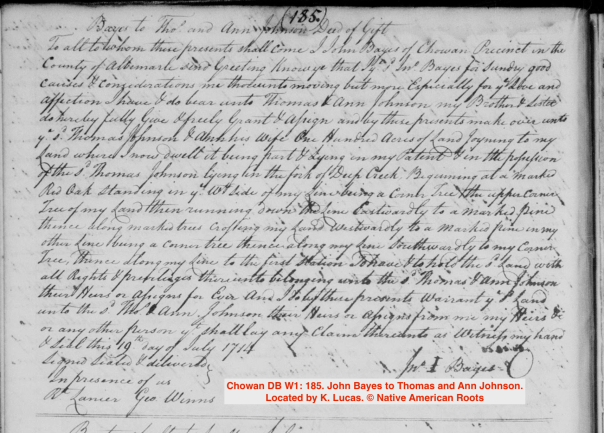 John Bayes made a deed of gift to his sister Ann Bayes Johnson and her husband Thomas Johnson as shown in this 1714 land deed.
John Bayes made a deed of gift to his sister Ann Bayes Johnson and her husband Thomas Johnson as shown in this 1714 land deed.
1. John Bayes to Thomas Johnson and Ann Johnson, Chowan DB W1, p. 185, July 19, 1714. Deed of gift to sister Ann Johnson and her husband Thomas Johnson 100 acres joining his land being part of his patent where he dwells and in the possession of Thomas Johnson lying in the fork of Deep Creek; witness Robert Lanier & George Winns
2. Thomas Johnston & wife Ann to John Gilbert, Bertie Deed Book A, p. 321-323, July 19, 1724. 40 lbs. For 270 acres on Deep Creek where Johnston formerly lived. Adj. John Bayes, John Williams. Wit: William Whitfield, Charles Caveneah. November Court 1724. John Sutton D.C./C.
3. John Grady (Graddy) to Alexander Cotton, Bertie DB D, p. 197, January 22, 1734. 150 pounds for 320 acres Known by the name of Deep Creek Granted to John Bays on Aprl 19, 1714. At fork of Deep Creek and head of Wiskfor branch. Wit: Job Rodgers, Jonas Griffin. May Court 1735. John Wynns D. C/C.
4. William Daniel to Jonathan Gilbert, millwright, Bertie DB D, p. 103, August 3, 1734. 745 pounds for 8 tracts of land. (1) On Deep Creek between “said creek and Wisktfor (?) Branch” adj. Coll. Frederick Jones” formerly John Bays’s which land was granted to James Rutland by patent August 1, 1714 and conveyd by Rutland to William Daniel.
Advertisements
REPORT THIS AD
From the above land deeds we learn that John Bayes gifted and sold land to his sister Ann Bayes and her husband Thomas Johnson and to his sister Eliza Bayes and her husband James Rutland in 1714. (Note: Due to laws of coverture, married women could not buy and sell land without the consent of their husband). We learn that John Bayes’s sisters later sold their land. In 1724, Ann Bayes and her husband Thomas Johnson sold their land to John Gilbert. Sometime between 1714 and 1734, Eliza Bayes and her husband James Rutland sold their land William Daniel who would sell it in 1734 to Jonathan Gilbert.
Wills and estate records for John Bayes and his sisters Ann Bayes Johnson and Eliza Bayes Rutland (or their spouses) have not been located. This presents a major challenge when trying to trace this family forward through time. Not having primary source records which name the next generation of offspring is a difficult work around. Furthermore, the family appears to have moved out of the area by the 1730s, when the land they formerly owned was in the possession of non family members.
What can be unequivocally stated from the above discussion is that John Bayes of Deep Creek (Hertford Co, NC) is not the same man as John Bass (1672-1732) of Norfolk/Nansemond, Horsepool Swamp (Gates Co), and Urahaw Swamp (Northampton Co). When Edward Bayes died in Chowan County in 1696 where he left a will giving his land to his son John Bayes, the other John Bass (1672-1732) was residing in Nansemond County, VA. How is this known? John Bass (1672-1732) was documented the same year in 1696 in Perquimans Co, NC, receiving a marriage bond to Love Harris. In that 1696 marriage record, John Bass (1672-1673) is called a resident of Nansemond County, VA. Therefore in 1696, Edward Bayes and his family were living in Deep Creek off of the Chowan River in present day Hertford Co, while John Bass (1672-1732) was residing in Nansemond County, VA with his family.
The will of John Bass (1673-1732) makes it clear that he is the John Bass of Urahaw Swamp because the will very specifically outlines his Urahaw Swamp land to be divided among his children. The 1732 will makes absolutely no mention of any land in Deep Creek and makes no mention of relatives names Bayes, or Ann Bayes Johnson or Eliza Bayes Rutland. There is no possible way to confuse the will of John Bass (1673-1732) with anyone else.
Advertisements
REPORT THIS AD
Bass researcher Lars Adams also provides a detailed analysis of the same records and comes to the exact same conclusion – the John Bayes of Deep Creek is not the same man as John Bass (1673-1732) of Horsepool Swamp and Urahaw Swamp.
A Closer Look at Urahaw Swamp and Neighboring Tribes
The fact that brothers Edward Bass and John Bass moved to North Carolina at the same time and bought adjoining land deserves further scrutiny. The Urahaw Swamp land that was first purchased in 1722/1723 is of particular interest because Bartholomew Chavis (1685-1750) also owned land along Urahaw Swamp. Bartholomew Chavis was the father of original Granville County land owner William Chavis (1706-1777) whose large land tract provided the land base for the Native American community in Granville. The earliest records for Bartholomew Chavis are found in Henrico and Surry County, VA. By 1719/1720 he was living in North Carolina and started purchasing land along Urahaw Swamp just 2-3 years before the Bass brothers purchased land there.
 Map of the southern portion of Northampton County, NC. I circled Urahaw Swamp which runs off of Potecasi Creek which I also circled. Potecasi Creek enters Northampton from the eastern border with Hertford. Urahaw Swamp breaks off from Potecasi and runs westward and ends on the northern side of the Roanake River along the Halifax County border.
Map of the southern portion of Northampton County, NC. I circled Urahaw Swamp which runs off of Potecasi Creek which I also circled. Potecasi Creek enters Northampton from the eastern border with Hertford. Urahaw Swamp breaks off from Potecasi and runs westward and ends on the northern side of the Roanake River along the Halifax County border.Source: http://dc.lib.unc.edu/cdm/singleitem/collection/ncmaps/id/8072/rec/18
The Gibson family is another Native American family who are relevant to this discussion. The Gibsons were originally from Charles City County, Virginia where one of the earliest Gibson family members, Jane Gibson (the elder), was known as a free Indian woman. She is the female progenitor of the Evans family who settled in Granville. You can read my Evans/Gibson blog post here. The previously mentioned William Chavis (1706-1777)‘ wife was Frances Gibson. Her brother John Gibson who lived nearby, was a witness to a 1728 land purchase along Urahaw Swamp made by Edward Bass (1672-1750). This shows a direct earlier connection between the Basses and Gibsons. Two of John Gibson’s sons – George Gibson and Charles Gibson moved to Granville in 1750. This was the far southwestern part of the county that just two years later became Orange County. George and Charles Gibson did not stay in Orange County for along and moved around quite a bit with their descendants eventually leaving the state. William Chavis (1706-1777) also owned some land in Orange County and perhaps that is connected to George and Charles Gibson’s temporary residence there. Despite inheriting his father’s Northampton County land in 1750, William Chavis (1706-1777) continued to live in Granville County. William even continued to have additional land transactions in Northampton County but Granville was his primary residence as indicated in the tax records. So with William Chavis being the first from Urahaw Swamp to relocate to Granville, it appears the Bass/Anderson family followed him there several years later. Much more research is needed to learn why these families moved from Northampton to Granville.
Advertisements
REPORT THIS AD
I find it interesting that a Nottoway(?) Indian named George Skipper b. 1685 was documented through land transactions, living along Urahaw Swamp in the 1720s (See Heinegg here). This is the exact same time that the Chavis, Gibson, Bass, and Anderson families lived along Urahaw Swamp. George Skipper’s wife was Nottoway Indian Mary Bailey, the apparent daughter of Wat Bailey who was documented on the Nottoway Indian reservation in Southampton County, VA. George Skipper and Mary Bailey’s son George Skipper b. 1720 was one of the chief men of the Nottoway Indian Nation who sold his land in 1749. When we take a look at the Moseley map of 1733, we see both the Meherrin and the Nansemond Indians living in close proximity to Urahaw Swamp. The Nottoway and Meherrin are part of the same Iroquoian speaking confederacy. And some of the Nansemond lived with the Nottoway on the Nottoway reservation in Southampton Co, VA (across the state line from Northampton Co, NC). This was an area where a number of tribes took refuge with one another, and this historical context is important for understanding Urahaw Swamp and the cluster of mixed race Native American families who resided there.
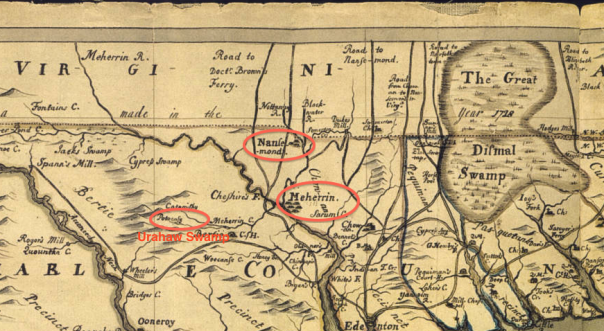 A portion of the Moseley Map of 1733. Urahaw Swamp is shown west of the Nansemond and Meherrin tribes which are circled. Source: http://ncpedia.org/moseley-manuscript-map
A portion of the Moseley Map of 1733. Urahaw Swamp is shown west of the Nansemond and Meherrin tribes which are circled. Source: http://ncpedia.org/moseley-manuscript-map
So why did some Nansemond Indians leave the Virginia homeland and settle with other friendly tribes? According to scholar Helen Rountree, the Basses belonged to the so-called “Christianized-Nansemond”, and were never granted a reservation like other Virginia tribes (Pamunkey, Mattaponi, Gingaskin, etc). The “traditional” Nansemond did live on a reservation in Southampton County, VA with the Nottoway Tribe. By 1792 they sold off their remaining reservation land. A closer genealogical examination of the Nansemond/Nottoway families on the Nottoway reservation shows that some individuals (such as George Skipper mentioned above) did leave the reservation for nearby Native American communities. In other words, in the 1700’s there were both Christianized and Traditional Nansemond who were not tied down to the traditional Nansemond homeland along the Nansemond River. This is a great avenue for additional deep dive research into a time and place that I believe is understudied. Thus I think a reexamination of Nansemond ethnohistory that is inclusive of the large amount of Nansemond Bass family members who moved to North Carolina, is long overdue.
 Map showing the location of the “Christianized Nansemond” that the Bass family belonged to.
Map showing the location of the “Christianized Nansemond” that the Bass family belonged to.Source: Helen Rountree
Without a bordered, recognized land base, it seems the Basses were pushed out of Virginia as a result of encroachment by Anglo colonists. This brings to mind Edward Bass’ (1672-1750) 1715 court case against John Muns Jr. for riding his mare. North Carolina at that time was still the “frontier” and that is where the Basses decided to make their home. The Basses were not the only Native American family from the Virginia tidewater area that made this journey. I suspect a number of Native American families in Granville that have tidewater Virginia roots, were Algonquian speaking peoples who were pushed out due to encroachment. Even Algonquian speaking peoples as far as away the Nanticoke Pukham/Bookram family, the Piscataway Proctor family and the Lenape Okey family moved to Granville County.
The Nansemond Basses in Granville County
So to summarize: all of the children of Edward Bass (1672-1750) and four of the children of John Bass (1673-1732) relocated to Granville County in the 1750’s. Edward Bass and John Bass were brothers, and the grandsons of John Bass(e) an English colonist and his Nansemond Indian wife Elizabeth. In Granville, these Bass descendants practiced endogamy by intermarrying with their own Bass cousins and other Native American families to form a tightly closed kinship network. As a result, most living Bass descendants from Granville have multiple Bass ancestors. For example, I have a cousin who has at minimum, 14 different documented Bass genealogical pedigrees back to Elizabeth the Nansemond.
 According to local historian Oscar Blacknall, William Chavis (1706-1777) originally owned land that stretched from Lynch’s Creek 16 miles upstream to Fishing Creek and went 5 miles inland from the Tar River. This is approximately 80 square miles or 51,200 acres of continuous land. This is the land base for the community. When the Bass family began to move to Granville County in the 1750’s, they settled on this land of their former Chavis neighbors in Urahaw Swamp in Northampton County, NC.
According to local historian Oscar Blacknall, William Chavis (1706-1777) originally owned land that stretched from Lynch’s Creek 16 miles upstream to Fishing Creek and went 5 miles inland from the Tar River. This is approximately 80 square miles or 51,200 acres of continuous land. This is the land base for the community. When the Bass family began to move to Granville County in the 1750’s, they settled on this land of their former Chavis neighbors in Urahaw Swamp in Northampton County, NC. © Kianga Lucas
The Bass family continued living and thriving in Granville County as can be seen from a variety of primary source records. The Basses are found in very high numbers in the census records, marriage records, land deeds, estate records, military pension records, tax lists and more. In 1800, there were 14 Bass heads of households, in 1810: 10 heads of household, in 1820: 7 heads of household, in 1830: 6 heads of household, and in 1840: 6 heads of household. In the 1850 census where every household member was enumerated by name for the first time, there were approximately 24 Basses in Granville, and in 1860 there were approximately 25 Basses in Granville. By the 1940 census which is the last publicly available census, there were approximately 100 Basses in Granville. These head counts of course do not reflect female Basses whose surnames changed due to marriage and do not include Bass descendants whose surnames were no longer Bass.
Advertisements
REPORT THIS AD
Brothers Benjamin Bass (1722-1800) and Edward Bass (1728-1800) who were the sons of Edward Bass (1672-1750) and Lovewell, became the largest land owners of the Bass family in Granville. Benjamin Bass owned at least 500 acres of total land and Edward Bass owned at least a total of 206 acres of land as reflected in the Granville tax lists and land deeds. They also married their own Bass cousins. Benjamin Bass married his first cousin Mary Bass, and Edward Bass married his first cousin, once removed Tamer Anderson.
 Family tree of Benjamin Bass (1722-1800) who was married to his first cousin Mary Bass (b. 1722). © Kianga Lucas
Family tree of Benjamin Bass (1722-1800) who was married to his first cousin Mary Bass (b. 1722). © Kianga Lucas

 Land deed showing that Benjamin Bass (1722-1800) purchased a whopping 480 acres in Granville County on 5 August 1782.
Land deed showing that Benjamin Bass (1722-1800) purchased a whopping 480 acres in Granville County on 5 August 1782. Family tree of Edward Bass Jr (1728-1800) who married his first cousin, once removed Tamer Anderson (b. 1742). © Kianga Lucas
Family tree of Edward Bass Jr (1728-1800) who married his first cousin, once removed Tamer Anderson (b. 1742). © Kianga Lucas
Benjamin Bass (1722-1800) and Edward Bass (1728-1800) had a brother named Sampson/Samuel Bass (b. 1726) whose identity has been conflated with other men who share the same name, by researcher Paul Heinegg. What follows is an explanation of this mistake, so if you are using Paul Heinegg’s research to document this Sampson/Samuel Bass, please proceed with caution.
 A selection from Paul Heinegg’s summary of the Bass family. In his discussion of Sampson/Samuel Bass b. 1726 (son of Edward Bass 1672-1750 and Lovewell), he incorrectly attributes records belonging to a different Samuel Bass. Please take caution and read my discussion of the mix-up below.
A selection from Paul Heinegg’s summary of the Bass family. In his discussion of Sampson/Samuel Bass b. 1726 (son of Edward Bass 1672-1750 and Lovewell), he incorrectly attributes records belonging to a different Samuel Bass. Please take caution and read my discussion of the mix-up below.
The conflation of Sampson/Samuel Bass b. 1726 (son of Edward Bass 1672-1750) and Samuel Bass 1712-1789 (parentage unknown) of Brunswick Co, VA/Northampton Co, NC and his son Samuel Bass Jr (1734-1796):
Advertisements
REPORT THIS AD
The first Sampson/Samuel Bass b. 1726 (he is called by both first names in the primary source records), was a tithable and land owner in Granville County. The available tax lists (1758, 1761, and 1762) show that he only paid tax on himself, so he appears to not have been married nor had any children. He was also taxed as a free person of color (free persons of color were required to pay taxes on their wives). In 1764, the part of Granville County he resided in became short lived Bute County and he makes a land purchase there in 1771. That is the last known record for him. So he may have died intestate and with no heirs.
On the other hand, the second Samuel Bass 1712-1789 (never referred to as Sampson Bass in any records) was taxed as white and was a wealthy planter who owned a lot of slaves. He resided in Brunswick Co, VA in 1765 when he gave his son Burwell Bass land in Northampton Co, NC (Brunswick and Northampton share a border). In 1765, the first Sampson/Samuel Bass resided in Granville, not Brunswick, so that should raise some initial red flags that we’re looking at two different men. He may also be the same Samuel Bass who appears as a tithable in the 1762 Northampton Co, NC tax list. In 1780 he was a tithable in Northampton, assessed on a large amount of property and 12 slaves. His 1787 Northampton Co will, proved in 1790, names his widow Sarah and children who received his property and slaves. This Samuel Bass had a son Samuel Bass Jr 1734-1796 named in the will. Samuel Bass Jr’s will was proved in 1796 in Greensville Co, VA (Greensville borders Brunswick and Northampton). Paul Heinegg also incorrectly attributes the Halifax Co, NC 1810 census showing a Samuel Bass head of a household of 7 free people of color and 1 slave to this Samuel Bass Jr. But that absolutely cannot be him since he was deceased by 1796. Instead the Samuel Bass enumerated in the 1810 census in Halifax Co, NC was a man named Samuel Bass b. 1784 who eventually moved to Tennessee, Alabama and finally Mississippi.
This RootsWeb tree which can be viewed here, includes the following statement from a Samuel Bass researcher who also agrees that the identities of these men have been conflated. He believes the second Samuel Bass was the Samuel Bass who made a 1733 land purchase in Isle of Wight, VA and lived next to Charles Bass Jr. and James Bass.
Advertisements
REPORT THIS AD
“I believe Heinegg and Marcia McClure and others have confounded a number of Samuels and Sampsons into one man. I am fifth great grandson of Samuel Bass, Sr who died in 1789 so I have spent a great amount of time trying to tease them apart. The Samuel Bass above was son of Samuel Sr. However I do not believe Samuel Sr was Sampson and the son of Edward. Through tracing land I place this man as the Samuel who purchased land in Isle of Wight County in 1733. He stated he was “of Isle of wight ” and the land adjoined property of James Bass and Charles Bass, Jr. They in subsequent years signed deeds for each other and moved about together. To me that says related. I have come to believe that Samuel was a son of Charles Bass, Sr of Isle if Wight Co. He was born most likely around 1712. He married twice. First to Elizabeth who was still alive in 1755. He was married to Sarah by 1770 and she is the wife in the will. He had 8 children who I believe were born in the order listed in the will. My ancestor Matthew could be the son of either wife.”
The Nansemond identity of the Basses in Granville County was known by Bass researcher, Albert Bell. While doing archival research for his book, Bass Families of the South, published in 1961, Albert Bell came across the 1833 Norfolk County, VA Indian certificates of several members of the Bass family in the Norfolk court minutes. Similar to the Norfolk court records from the 1700’s, the Nansemond Bass family found it necessary to clarify their identity as Indian peoples. Albert Bell submitted a copy of these 1833 Indian certificates and citations to the North Carolina State Archives in Raleigh and included a note which stated:
“The Basses of Norfolk County have been bedeviled by the same problem as that faced by the Granville County crowd.”
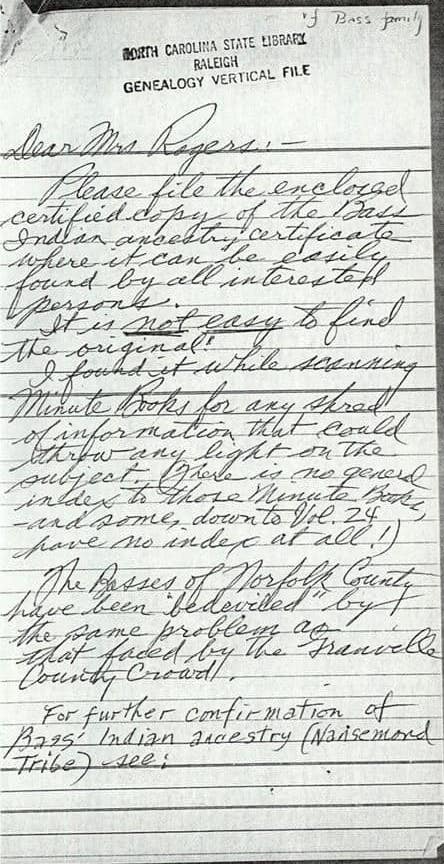 First page of the note left by Albert Bell in the North Carolina State Archives with a copy of the 1833 Norfolk Indian certificates of the Bass family. This note shows that Albert Bell hoped that these Indian certificates would be of help to establishing the Nansemond identity of the Granville County Bass family.
First page of the note left by Albert Bell in the North Carolina State Archives with a copy of the 1833 Norfolk Indian certificates of the Bass family. This note shows that Albert Bell hoped that these Indian certificates would be of help to establishing the Nansemond identity of the Granville County Bass family.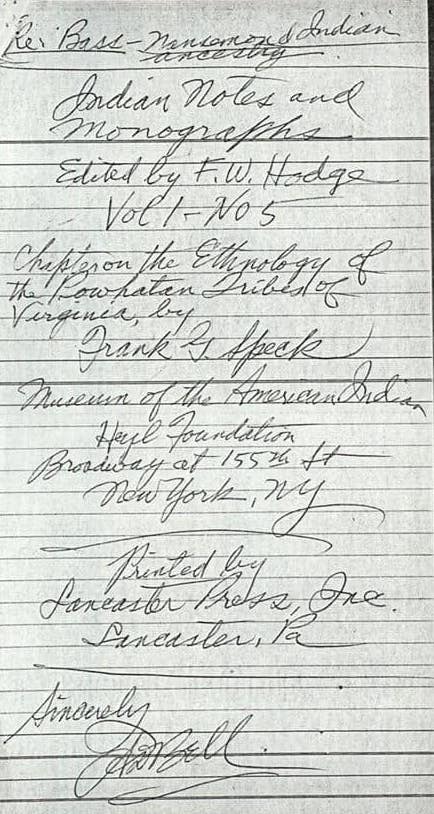 Second page of the note left by Albert Bell in the North Carolina State Archives. In it he provides additional sources about the Nansemond tribe written by ethnographers Frederick Webb Hodge and Frank Speck. On a personal side note, as a former curatorial assistant at the Southwest Museum of the American Indian in Los Angeles, I encountered Hodge’s work on a regular basis because he used to be director of the museum.
Second page of the note left by Albert Bell in the North Carolina State Archives. In it he provides additional sources about the Nansemond tribe written by ethnographers Frederick Webb Hodge and Frank Speck. On a personal side note, as a former curatorial assistant at the Southwest Museum of the American Indian in Los Angeles, I encountered Hodge’s work on a regular basis because he used to be director of the museum.
Nansemond Bass Genealogy in the Haliwa-Saponi Tribe
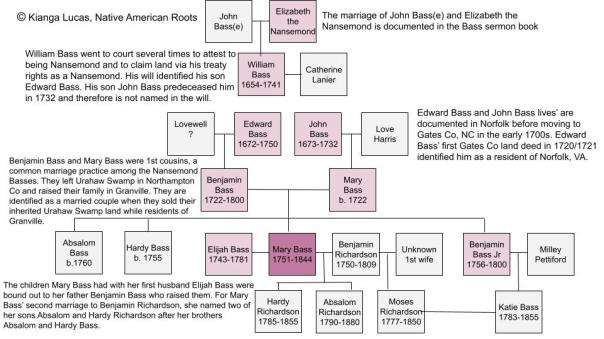 This is the family tree for Mary Bass (1751-1844) who is the main Naansemond progenitor of the Haliwa-Saponi Richardson family, but not the only one. Mary Bass’ brother Benjamin Bass Jr had a daughter named Katie Bass who married into the Richardsons. This tree shows every generation from Mary Bass back to John Bass(e) and Elizabeth the Nansemond. © Kianga Lucas, Native American Roots
This is the family tree for Mary Bass (1751-1844) who is the main Naansemond progenitor of the Haliwa-Saponi Richardson family, but not the only one. Mary Bass’ brother Benjamin Bass Jr had a daughter named Katie Bass who married into the Richardsons. This tree shows every generation from Mary Bass back to John Bass(e) and Elizabeth the Nansemond. © Kianga Lucas, Native American Roots
Mary Bass (1751-1844) and her husband Benjamin Richardson (1750-1809) are my 5th great-grandparents and are the main progenitors of the Haliwa-Saponi tribe. Mary Bass (1751-1844) has a documented Nansemond lineage through both of her parents, Benjamin Bass (1722-1800) and Mary Bass (b. 1722), who were first cousins. Before Benjamin Richardson, Mary Bass was married to her first cousin Elijah Bass (1743-1781) with a marriage bond dated 14 Feb 1777 in Bute Co, NC (formerly Granville Co).
 On 14 Feb 1777 in Bute County (formerly Granville Co), Elijah Bass filed a marriage bond for his marriage to Mary Bass. This record established that Mary Bass’ maiden name was Bass.
On 14 Feb 1777 in Bute County (formerly Granville Co), Elijah Bass filed a marriage bond for his marriage to Mary Bass. This record established that Mary Bass’ maiden name was Bass.
Elijah Bass (1743-1781) was the son of John Bass (1716-17480 who was the son of Edward Bass (1672-1750). This means Elijah Bass and Mary Bass were first cousins (their fathers were brothers). After becoming widowed, Mary Bass married Benjamin Richardson with a marriage bond dated 13 Feb 1783 in Granville Co, NC. It had been incorrectly assumed by some earlier researchers that Mary Bass (1751-1844) was the same Mary Bass who was the daughter of Thomas Bass (1723-1764) and Thomasine Bunch of Bertie Co. However I have extensively reviewed the records for Thomas Bass/Thomasine Bunch and their children and it is very clear that their daughter Mary Bass died in childhood and cannot possibly be Mary Bass (1751-1844) of Granville and later Halifax Co. Thomas Bass (1723-1764) was a grandson of John Bass (1673-1732) and Love Harris. He is documented as the husband of Tamerson Bunch who is identified as such in her father Henry Bunch’s 1775 Bertie Co will. Thomas Bass died young in 1764 and his will names his four minor children who were living at that time: John, Jacob, Mary, and Isbell. Thomas Bass’ sons John Bass and Jacob Bass are documented in the subsequent Bertie Co records as heads of white households who were often slave owning. No records attributed to them show any close or tangential relationship with Mary Bass (1751-1844) or her Richardson offspring.
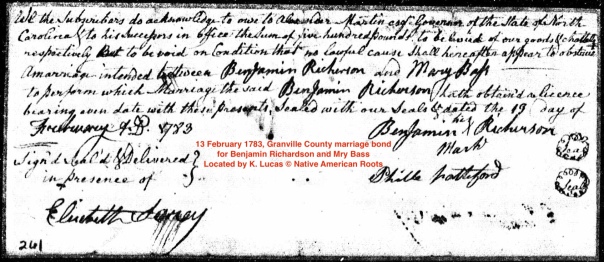 13 February 1783 Granville County marriage bond for Benjamin Richardson and Mary Bass. This record establishes that Mary Bass married for a second time while still residing in Granville County.
13 February 1783 Granville County marriage bond for Benjamin Richardson and Mary Bass. This record establishes that Mary Bass married for a second time while still residing in Granville County.
A closer examination of the records as well as DNA cousin matches between documented lineal descendants of Mary Bass and other members of the Bass family, shows that Mary Bass (1751-1844) was the daughter of Benjamin Bass (1722-1800) and his wife Mary Bass (b. 1722) of Granville County. When Mary Bass’ first husband Elijah Bass (1743-1781) died during the Revolutionary War, her father Benjamin Bass (1722-1822) became the legal guardian of her children (John, Phatha, Sarah, and David) as demonstrated in the Granville County, NC apprenticeship records. When Mary Bass married for a second time in Granville County to Benjamin Richardson who resided in Halifax County, the bondsman was Mary Bass’ relative Phillip Pettiford (1754-1825).who was the husband of Patience Bass. It was after her marriage to Benjamin Richardson that Mary Bass moved to Halifax Co where she raised her Richardson children. Mary Bass named two of her sons: Absalom Richardson (1790-1880) and Hardy Richardson (1788-1855) after her brothers Absalom Bass (b 1760) and Hardy Bass (b. 1755) who are both documented sons of Benjamin Bass (1722-1800) and Mary Bass (b. 1722) of Granville. Because Mary Bass outlived both of her husbands, Elijah Bass and Benjamin Richardson, who were Revolutionary War soldiers, she was able to successfully apply for a widow’s pension (W.4061). Her application which can be viewed on Ancestry here and on Fold3 here, confirm she is the same Mary Bass who first married Elijah Bass and second married Benjamin Richardson.
 On 4 February 1780, the Granville County court began to bound out the children of Elijah Bass and Mary Bass to Mary Bass’ father Benjamin Bass.
On 4 February 1780, the Granville County court began to bound out the children of Elijah Bass and Mary Bass to Mary Bass’ father Benjamin Bass.
Mary Bass’ brother Benjamin Bass Jr (1756-1800) also moved from Granville to Halifax at the very end of his short life. In 1799, the year before he died, Benjamin Bass Jr sold his land in Granville County (Granville DB Q:307) and he purchased 119 acres of land in Halifax County from Benjamin Richardson’s brother John Richardson (Halifax DB18: 480). Benjamin Bass Jr and his wife Milley Pettiford (Granville Co Marriage bond 2 Jan 1781) were the parents of 7 living children when he died the following year. One of his children was Katie Bass (1783-1825) who sold her 1/7 share (17 acres) in 1804 (Halifax DB19: 268). Katie Bass was the wife of Moses Richardson (1777-1850) who was the son of Benjamin Richardson (1750-1809) and his first unknown wife. As a result, there are Haliwa-Saponi who descend from Benjamin Bass Jr via his daughter Katie Bass.
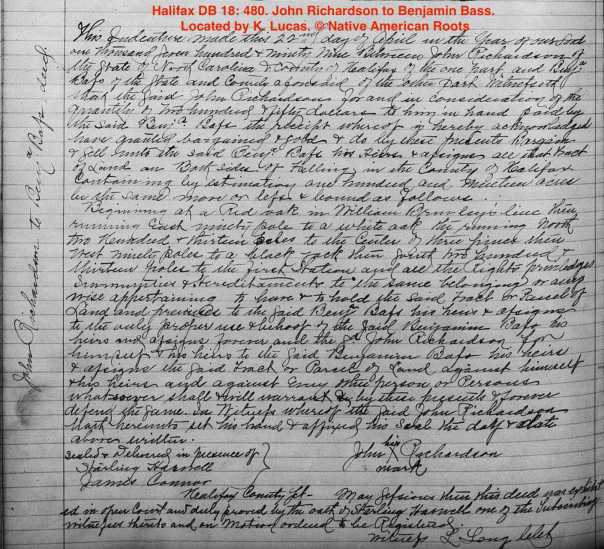 On 22 April 1799, Benjamin Bass Jr (1756-1800) purchased 119 acres of land in Halifax from his brother in law John Richardson (the brother of his sister Mary Bass’ husband Benjamin Richardson). This land deed indicates that Benjamin Bass Jr was also moving from Granville to Halifax like his sister Mary Bass.
On 22 April 1799, Benjamin Bass Jr (1756-1800) purchased 119 acres of land in Halifax from his brother in law John Richardson (the brother of his sister Mary Bass’ husband Benjamin Richardson). This land deed indicates that Benjamin Bass Jr was also moving from Granville to Halifax like his sister Mary Bass. On 8 February 1804, Katie Bass (1783-1825) sold her share of 17 acres of her deceased father Benjamin Bass Jr’s land. This document proves that Katie Bass was one of Benjamin Bass Jr’s seven surviving children. Katie Bass later married Moses Richardson and the couple are ancestors of present Haliwa-Saponi people.
On 8 February 1804, Katie Bass (1783-1825) sold her share of 17 acres of her deceased father Benjamin Bass Jr’s land. This document proves that Katie Bass was one of Benjamin Bass Jr’s seven surviving children. Katie Bass later married Moses Richardson and the couple are ancestors of present Haliwa-Saponi people.
This means that Haliwa-Saponi people descend from the Nansemond tribe via two documented grandchildren of John Bass(e) and Elizabeth the Nansemond: Edward Bass (1672-1750) and John Bass (1673-1732). There are also documented lineal descendants of Mary Bass (1751-1844) and her siblings enrolled as tribal citizens in the Nansemond Indian Nation, including past and current tribal council members and the current chief Keith F. Anderson (a descendant of Mary Bass’ sister Winnie Bass who married Lewis Anderson Jr).
Photos of Nansemond Basses from Granville County
Below are a handful of photos of individuals who come from the Nansemond Bass family in Granville County. Some of the Granville Basses in the following generations moved to neighboring and nearby counties such as Halifax, Person, Orange, Durham, and Alamance.
Advertisements
REPORT THIS AD
The Bass pedigree of the three brothers pictured below who were sons of William Bass b. 1831 and Sarah Evans is as follows:
William Bass; Cullen Bass; Prudence Bass; Edward Bass Jr; Edward Bass Sr; William Bass Sr; John Bass(e) the English colonist and Elizabeth daughter of the Nansemond chief.
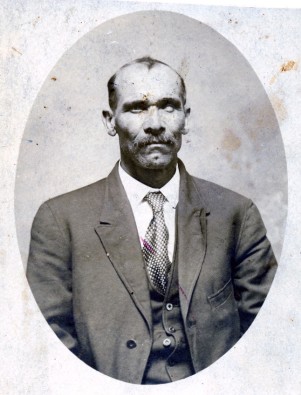 Alonzo Bass (1859-1941). Son of William Bass and Sarah Evans.
Alonzo Bass (1859-1941). Son of William Bass and Sarah Evans. Source: Ancestry, User: randymaultsby
 William Brammer Bass (1874-1962). Son of William Bass and Sarah Evans
William Brammer Bass (1874-1962). Son of William Bass and Sarah EvansSource: Ancestry, User: Derika73
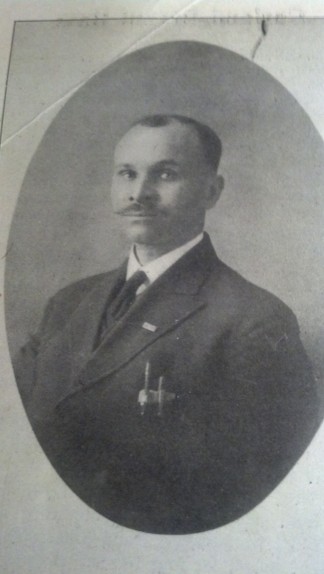 Garland Bryant Bass (1879-1935). Son of William Bass and Sarah Evans
Garland Bryant Bass (1879-1935). Son of William Bass and Sarah EvansSource: Ancestry, User: randymaultsby
 Joel Bass (1929-2012). Son of Buck Bass and Minnie Day and grandson of Alonzo Bass pictured above. Joel Bass was former chief of the Eno-Occaneechi Tribe (precursor to the state recognized Occaneechi-Saponi tribe). On Joel’s mother’s side he is descended from the Granville County Day, Stewart, Cousins and the Bass family again from the Edward Bass (1672-1750) line. Source: Richard Haithcock
Joel Bass (1929-2012). Son of Buck Bass and Minnie Day and grandson of Alonzo Bass pictured above. Joel Bass was former chief of the Eno-Occaneechi Tribe (precursor to the state recognized Occaneechi-Saponi tribe). On Joel’s mother’s side he is descended from the Granville County Day, Stewart, Cousins and the Bass family again from the Edward Bass (1672-1750) line. Source: Richard Haithcock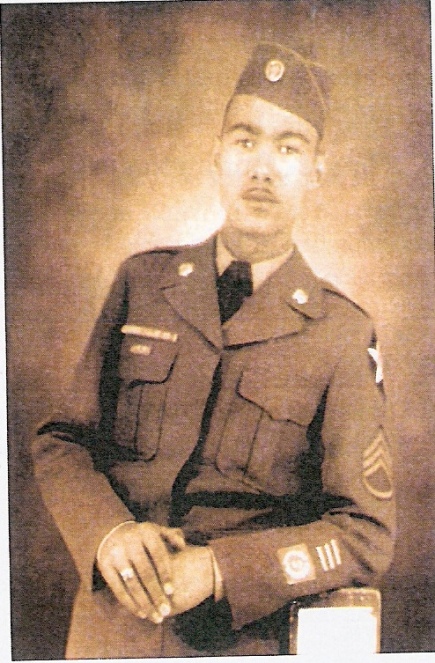 Joel Bass as a young man.
Joel Bass as a young man.Source: Ancestry, User: randymaultsby
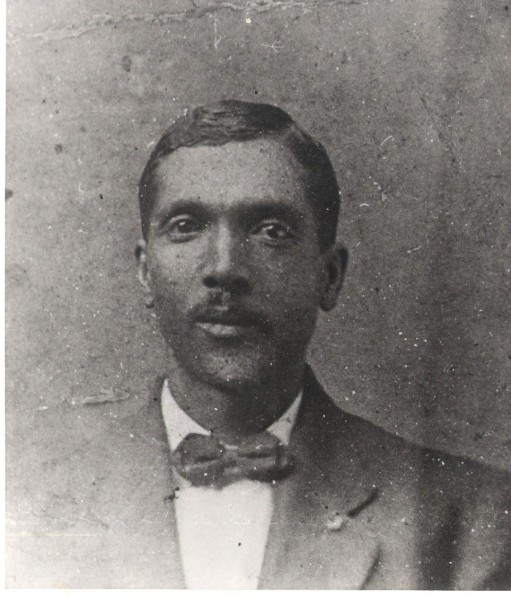 Alford Pettiford born 1877
Alford Pettiford born 1877Resident of Fishing Creek, Granville County, NC.
His parents were James Pettiford and Frances Brandon. Alford Pettiford has multiple Bass lines that trace back to both brothers Edward Bass (1672-1750) and John Bass (1673-1732). One of his Bass lineages is as follows:
Alford Pettiford; James Pettiford; William Pettiford; Dicey Bass; Nathan Bass; Lovey Bass; John Bass; William Bass; John Bass(e) the English colonist and Elizabeth daughter of the Nansemond chief. Source: Rod Daye
 Cappie Frances Anderson (1882-1947). Cappie was a resident of Fishing Creek, Granville County, North Carolina. Her parents were James Anderson and Emma Taborn. Cappie Frances Anderson has multiple Bass lineages going back to both brothers Edward Bass (1672-1750) and John Bass (1673-1732). One of her Bass lineages is as follows:
Cappie Frances Anderson (1882-1947). Cappie was a resident of Fishing Creek, Granville County, North Carolina. Her parents were James Anderson and Emma Taborn. Cappie Frances Anderson has multiple Bass lineages going back to both brothers Edward Bass (1672-1750) and John Bass (1673-1732). One of her Bass lineages is as follows:Cappie Anderson; James Anderson; Winnie Anderson; Henry Anderson; Rhody Anderson; Winnie Bass; Benjamin Bass; Edward Bass; William Bass; John Bass(e) the English colonist and Elizabeth daughter of the Nansemond chief. Source: Rod Daye
 Joseph Walter Scott (1872-1938) of Granville/Vance Counties, was the son of John Scott and Sally Emeline Taborn. His maternal grandparents were Arthur Taborn and Henrietta Bass. Source: Ancestry, Username: ellemoorehp
Joseph Walter Scott (1872-1938) of Granville/Vance Counties, was the son of John Scott and Sally Emeline Taborn. His maternal grandparents were Arthur Taborn and Henrietta Bass. Source: Ancestry, Username: ellemoorehp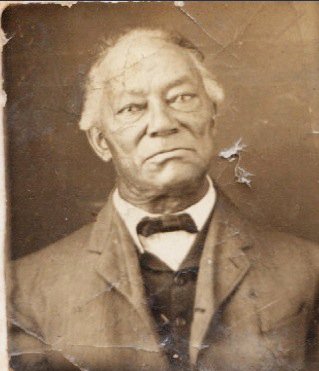 John Anderson (1832-1916) was the son of Thomas Anderson and Sally Day of Granville County. He was first married to Margaret Parker and second married to Mary Mayo. He has multiple Bass pedigrees. One of sis Bass pedigree is as follows: John Anderson; Thomas Anderson; Winnie Bass; Edward Bass; William Bass; John Bass(e) the English colonist and Elizabeth daughter of the Nansemond chief. Source: Christopher Bradley Cooper
John Anderson (1832-1916) was the son of Thomas Anderson and Sally Day of Granville County. He was first married to Margaret Parker and second married to Mary Mayo. He has multiple Bass pedigrees. One of sis Bass pedigree is as follows: John Anderson; Thomas Anderson; Winnie Bass; Edward Bass; William Bass; John Bass(e) the English colonist and Elizabeth daughter of the Nansemond chief. Source: Christopher Bradley Cooper On the right Eliza Louisa Richardson (1828-1909) and on the left her niece Emily Richardson (1840-1910/1920) of Halifax County, NC. Eliza Louisa Richardson was the daughter of Hardy Richardson and Dorcas Boone. They descend from the Granville Bass family. This photo was submitted with the Richardson family’s rejected Dawes Cherokee Dawes applications in 1898. Source: The National Archives. Eliza Louisa Richardson’s Bass pedigree is as follows: Eliza Louisa Richardson; Hardy Richardson; Mary Bass; Benjamin Bass; Edward Bass; William Bass; John Bass(e) the English colonist and Elizabeth the daughter of the chief of the Nansemond.
On the right Eliza Louisa Richardson (1828-1909) and on the left her niece Emily Richardson (1840-1910/1920) of Halifax County, NC. Eliza Louisa Richardson was the daughter of Hardy Richardson and Dorcas Boone. They descend from the Granville Bass family. This photo was submitted with the Richardson family’s rejected Dawes Cherokee Dawes applications in 1898. Source: The National Archives. Eliza Louisa Richardson’s Bass pedigree is as follows: Eliza Louisa Richardson; Hardy Richardson; Mary Bass; Benjamin Bass; Edward Bass; William Bass; John Bass(e) the English colonist and Elizabeth the daughter of the chief of the Nansemond. Seated in the front are siblings Sally Richardson (1862-1951) and Henry Richardson (1871-1964) (children of Cofield Richardson and Rachel Mary Lynch) of Halifax County, NC with Sally Richardson’s daughter standing in the back. They descend from the Granville Co Bass family. Their Bass pedigree is as follows: Sally Richardson/Henry Richardson; Cofield Richardson; Absalom Richardson; Mary Bass; Benjamin Bass; Edward Bass; William Bass; John Bass(e) the English colonist and Elizabeth the daughter of the Nansemond Chief. Source: Donnie Hansberry.
Seated in the front are siblings Sally Richardson (1862-1951) and Henry Richardson (1871-1964) (children of Cofield Richardson and Rachel Mary Lynch) of Halifax County, NC with Sally Richardson’s daughter standing in the back. They descend from the Granville Co Bass family. Their Bass pedigree is as follows: Sally Richardson/Henry Richardson; Cofield Richardson; Absalom Richardson; Mary Bass; Benjamin Bass; Edward Bass; William Bass; John Bass(e) the English colonist and Elizabeth the daughter of the Nansemond Chief. Source: Donnie Hansberry. This is a very special picture, because it captured the descendants of three Nansemond brothers, Edward Bass (1672-1750), John Bass (1673-1732) and Thomas Bass (1687-?), grandsons of John Bass(e) and Elizabeth the Nansemond. On the far left is Southall Bass III (1913-1991) who is a direct male descendant of Thomas Bass (1687-?). His family remained in Norfolk and Southall Bass became a noted local photographer. Standing next to him is his friend and distant cousin Eva Richardson (1924-2007) originally of Halifax County, NC but resided in the Hampton Roads, Virginia area. Eva Richardson’s 4th great-grandmother (and four times repeated) was Mary Bass (1751-1844) who married Benjamin Richardson. Thus, Eva Richardson descends from both Edward Bass (1672-1732) and John Bass (1673-1750) four times over. Photo courtesy of Eva Richardson’s son Rod Northern.
This is a very special picture, because it captured the descendants of three Nansemond brothers, Edward Bass (1672-1750), John Bass (1673-1732) and Thomas Bass (1687-?), grandsons of John Bass(e) and Elizabeth the Nansemond. On the far left is Southall Bass III (1913-1991) who is a direct male descendant of Thomas Bass (1687-?). His family remained in Norfolk and Southall Bass became a noted local photographer. Standing next to him is his friend and distant cousin Eva Richardson (1924-2007) originally of Halifax County, NC but resided in the Hampton Roads, Virginia area. Eva Richardson’s 4th great-grandmother (and four times repeated) was Mary Bass (1751-1844) who married Benjamin Richardson. Thus, Eva Richardson descends from both Edward Bass (1672-1732) and John Bass (1673-1750) four times over. Photo courtesy of Eva Richardson’s son Rod Northern.
